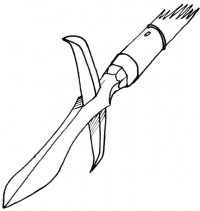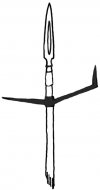Written by Kagita Chūbee, 20th sōke of the Hōzōinryū
Types of Spears
This time I would like to introduce the various types of spears.
 Suyari:
Suyari:
This is the most common type of spear. As its name "simple spear" implies this is a spear with a straight blade. In ancient times this denomination was not used because then this was the only type of spear there was. The term suyari first came to be used during the Sengoku period1 when different types of spears as the kamayari or the kagiyari evolved.
Kamayari:
 The blade of a "sickle-spear" has one or two "sickels" (additional blades) going off the main blade. Due to these additional blades the kamayari has an advantage over the suyari because with this kind of blade it is possible to cut with a draw, deflect an attack or beat down an opponents weapon in a circular movement. Concerning form, length or angle of the additional blades there had been the most different developments. At the end of the Sengoku period the kamayari came into the spotlight as the personal weapon of choise of the great generals. Katō Kiyomasa's2 katakamayari, Katagiri Katsumoto's3 techigai-jūmonjiyari4 oder Mori Nagayoshi's5 big jūmonjiyari are still spoken of even today. At the same time the use of the kamayari developed into a martial art. At first there were no independent styles but in the Momoyama period6 Hōzōin Inei's7 art of the use of the jūmonjikamayari established itself as an outstanding school which was then refinded increasingly by his able successors. Usually the shafts of kamayaris are shorter than those of suyaris. One reason for this is the fact that their blades are heavier than those of suyaris. The more important reason though is that - making good use of the sickles - it is more easy to get to the opponent or apply techniques like hikitotoshi8 oder makiotoshi9 with a slightly shorter kamayari.
The blade of a "sickle-spear" has one or two "sickels" (additional blades) going off the main blade. Due to these additional blades the kamayari has an advantage over the suyari because with this kind of blade it is possible to cut with a draw, deflect an attack or beat down an opponents weapon in a circular movement. Concerning form, length or angle of the additional blades there had been the most different developments. At the end of the Sengoku period the kamayari came into the spotlight as the personal weapon of choise of the great generals. Katō Kiyomasa's2 katakamayari, Katagiri Katsumoto's3 techigai-jūmonjiyari4 oder Mori Nagayoshi's5 big jūmonjiyari are still spoken of even today. At the same time the use of the kamayari developed into a martial art. At first there were no independent styles but in the Momoyama period6 Hōzōin Inei's7 art of the use of the jūmonjikamayari established itself as an outstanding school which was then refinded increasingly by his able successors. Usually the shafts of kamayaris are shorter than those of suyaris. One reason for this is the fact that their blades are heavier than those of suyaris. The more important reason though is that - making good use of the sickles - it is more easy to get to the opponent or apply techniques like hikitotoshi8 oder makiotoshi9 with a slightly shorter kamayari.
 Jūmonjiyari:
Jūmonjiyari:
The "cross-spear" is a subtype of kamayari. The additional blades on both sides of the main blade are of equal length. This spear ows its name to its cross shaped blade. This is the type of spear we use in the Hōzōinryū. With this kind of spear not only thrusting is possible but one can use it to cut down an opponents spear, to fling it down in a circular movement or to slide towards the opponents leading hand along the shaft of his spear.
Katakamayari:
The "one-sided sickle-spear" also is a subtype of kamayari. Its blade resembles that of a jūmonjiyari with one of the additional blades missing10.
 Kagiyari:
Kagiyari:
The "key-spear" has a crossguard below its blade which can be used to controll an opponents weapon or to fling it down. It ows its name to the fact that the crossguard usually is L-shaped.
 Kudayari:
Kudayari:
The "tube-spear" is a suyari the shaft of which is running through a loosly fitting sleeve of a hand breadth's length. This sleeve or tube is held with the left hand. The right hand grips the shaft directly thrusts the spear forwards and pulling it backwards through the sleeve. This is done effortlessly because the sleeve offers only minimal frictional resistance. Something resembling the kudayari is neither found in China nor in the West. So it is justified to call it an original Japanese invention.
Ōmiyari:
The term "spear with a large blade" is used for spears with a long blade. This applies to suyaris as well as to kamayaris11. Usually a blade length between approximately 12 and 21 cm are sufficient for effective thrusting. Nevertheless there are spears with a blade length of one or two shaku, in rare cases even more than four shaku (approx. 30 - 120 cm). These spears are called ōmiyari.
Nagaeyari:
"Long shafted spears" literally have long shafts. The term is not used for spears that are only long but for those extraordinarily long weapons which were issued to the infantry and used in group fighting. These spears not only were much longer than average but they were issued by the feudal lords to their spear troops as identical weapons, used coordinated in the group on command. Nagaeyari reached from approximately 4,50 m up to 6,40 m. In the peaceful Edo period12 they were still used as ceremonial weapons. It must have been an impressive sight when long rows of such spears passed by13.
(First published in the Nara town magazine Ubusuna on March 5th 2009)
1. 1467 – 1568
2. 1562 - 1611; lord of Higo and one of the "seven spears of Shizugatake" (also see episode 2); Katō Kiyomasa also was a renowned architect of castles and fortifications.
3. 1556 - 1615; another of the "seven spears of Shizugatake".
4. Literally: incorrect jūmonjiyari. The additional blades of this kind of Spear do not lie in the same plane as the main blade but are attached to it shifted by 90 degrees.
5. 1558 – 1584
6. 1583 – 1602
7. 1521 - 1607
8. Cutting down.
9. Flinging down in a circular movement.
10. Or with one of the blades very short or just suggested.
11. Of course kagiyaris can be ōmiyaris as well. The kagiyari used in the Saburiryū for example is an ōmi-kagiyari.
12. 1603 - 1868
13. For example in daimyō processions.